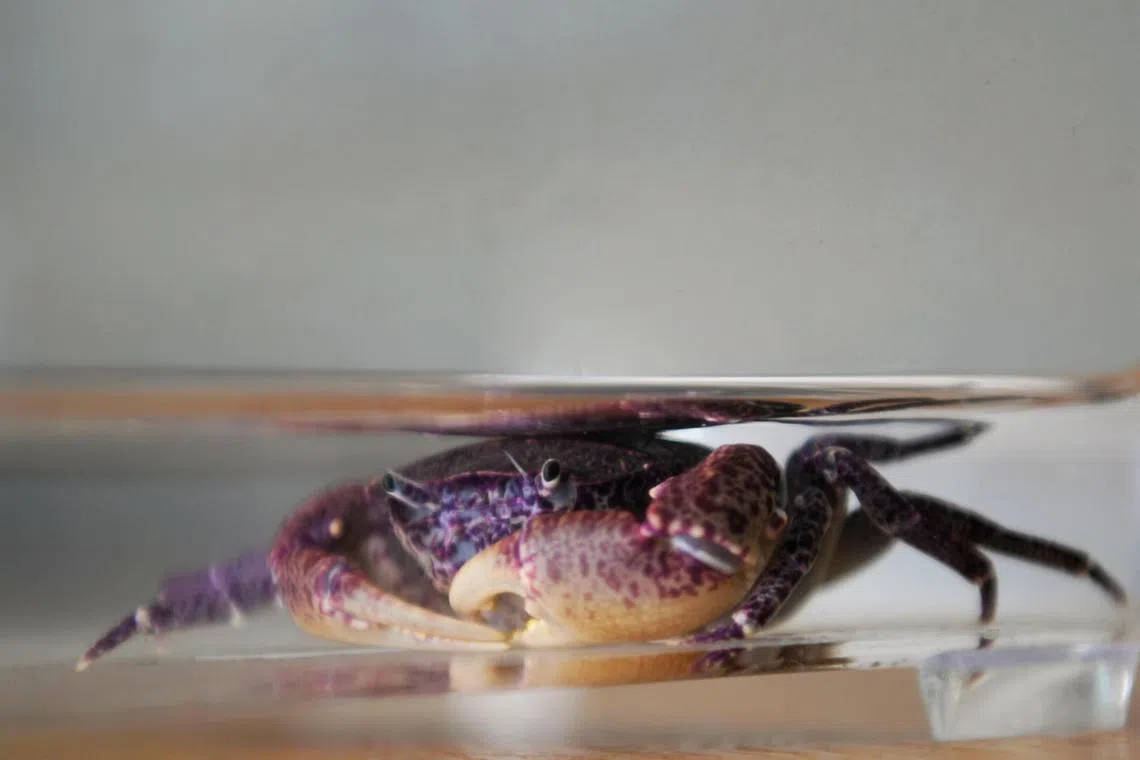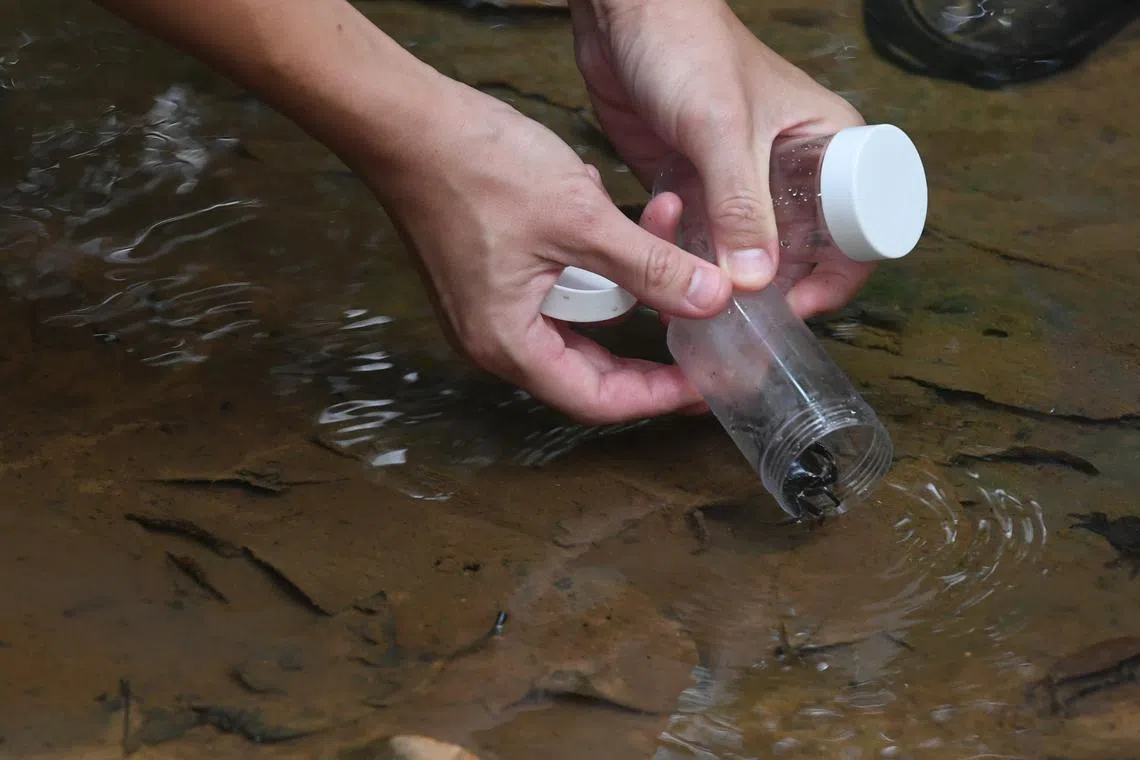Rare Singapore swamp forest crab species gets boost in the wild with release of captive-bred specimens
Sign up now: Get ST's newsletters delivered to your inbox

A total of 20 specimens of the critically endangered Singapore swamp forest crab were released into a stream at an undisclosed nature park on June 20.
ST PHOTO: AZMI ATHNI
Follow topic:
SINGAPORE - Work is under way to shore up the wild numbers of a rare crab species found only in and around Singapore’s last freshwater swamp forest.
On Tuesday, 20 specimens of the critically endangered Singapore swamp forest crab (Parathelphusa reticulata) were released into a stream at an undisclosed nature park.
The crustaceans – which can grow up to 4cm across – were hatched in captivity by the National Parks Board (NParks) as part of efforts to restock the wild population, estimated to be a few hundred.
The crabs were bred at NParks’ National Biodiversity Centre (NBC). About 480 baby crabs were hatched from 12 adult crabs caught in Nee Soon Swamp Forest in 2018.
Efforts to restock dwindling populations of wild crab species in Singapore began in 2014, starting with the most endangered of the three freshwater crabs – the pebble-size Singapore freshwater crab (Johora singaporensis). The other crab is the Johnson’s freshwater crab, which is also endangered. All three species are found nowhere else in the world.
The breeding programme is part of a national scheme to put in place by 2030 conservation plans for 160 species of rare or threatened native flora and fauna or those that can be found only in Singapore.
So far, more than 120 species have been included in the scheme.
NBC group director Ryan Lee said NParks is making it a priority to help species like the Singapore swamp forest crab that are threatened by extinction. “This ensures the long-term survival of native biodiversity in the face of urbanisation and climate change.”
NBC manager Daniel Ng, who recently helped write a paper on Singapore swamp forest crab breeding, said: “The bulk of the crab’s population is found in Nee Soon. This means all the eggs are in one basket and if something happens to the site itself, the crab will be wiped out.”
Freshwater crabs play a key role in the ecosystem by releasing nutrients into streams when they feed on leaf litter – their main food source – and breaking down leaves for other animals to eat.
National University of Singapore (NUS) Professor Peter Ng – who in 1990 was the first person to identify the nocturnal Singapore swamp forest crab as a new species – named the animal after its unique colour pattern.
But little is known about the highly secretive crab’s life cycle and behaviour in the wild as it often hides in burrows or under leaf litter, which makes them difficult to observe, said Dr Daniel Ng, who has been studying crabs for more than a decade.
Since the breeding programme began in 2018, researchers have observed the crabs and realised the animal could tolerate conditions less acidic than the slow-flowing waters of the swamp forest habitat, which meant the crabs could be suited for life outside the Nee Soon Swamp Forest.

The crustaceans were hatched in captivity by NParks as part of efforts to restock the wild population, estimated to be a few hundred.
ST PHOTO: AZMI ATHNI
They also found that the aggressive crabs would fight if placed in the same tank for long periods. So breeders separated them after 24 hours to make sure the solitary creatures did not lose their limbs when mating.
Before Tuesday’s crustacean release, NParks staff had also released two sets of crab offspring in Nee Soon Swamp Forest, keeping about 80 crabs for research.
As for the Singapore freshwater crab, Mr Lee said more than 100 second-generation crabs have been bred in captivity in 2023, after many failed attempts. The crab is usually found in hill streams in Bukit Batok and Bukit Gombak.
Researchers will return to the nature park at night in July to study the health of the released Singapore swamp forest crabs, which are now about 2cm in size, said Dr Ng. There are no predators, so they are likely to survive, he added.
He said: “If we find that the crabs have grown bigger, we will introduce more to establish a population.”
There was some concern over scavenging crabs competing with another freshwater crab species in the area for food, but Dr Ng said the overlap between the two species is likely to be small, given their size difference.
Associate Professor Darren Yeo, a crab expert who helms the NUS Lee Kong Chian Natural History Museum, said there should not be another native species in the same habitat that might be threatened by the crab’s presence.
“Singapore may be the first place to attempt and succeed in such captive-breeding efforts for freshwater crab conservation,” said Prof Yeo, who started in 2014 a roundtable discussion that kick-started local crab conservation efforts.
“Crabs produced through captive-breeding can be kept and grown in captivity to serve as an assurance against the loss or decline of the wild population.”
Correction note: The scientific name of the Singapore freshwater crab (Johora singaporensis) was mispelled in an earlier version of the story, and has been corrected. We are sorry for the error.


